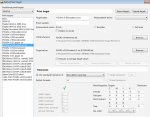gordo
Well-known member
Is there any ISO/GRACoL 7 specification for color tolerances for anything other that printed solids?
My understanding is that a printed solid must be less than a Delta E of 5 (1976?)
But what about an arbitrary color build? E.g. The patches in an iT8 target? Must they also be less than a Delta E of 5?
My understanding is that a printed solid must be less than a Delta E of 5 (1976?)
But what about an arbitrary color build? E.g. The patches in an iT8 target? Must they also be less than a Delta E of 5?














